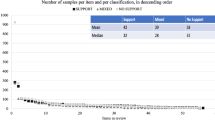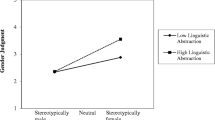Abstract
This experiment investigated the propensity of the generic he to evoke images of males relative to he/she and the plural they. Undergraduates read sentences aloud and verbally described the images that came to mind. The results provide strong support for the hypothesis that the generic he evokes a disproportionate number of male images. Results also suggest that while the plural they functions as a generic pronoun for both males and females, males may comprehend he/she in a manner similar to he. Theoretical implications for a critique of sexist language and prescribing generic pronoun usage are considered.
Similar content being viewed by others
References
APA Publication Manual Task Force. (1977). Guidelines for nonsexist language in APA journals: Publication Manual change sheet 2. American Psychologist, 32, 487–494.
Bem, S., & Bem, D. (1973). Does sex-biased job advertising “aid and abet” sex discrimination? Journal of Applied Social Psychology, 3, 6–18.
Bendix, E. (1979). Linguistic model as political symbols: Gender and the generic “he” in English. In J. Orasanu, M. Slater, & L. Adler (Eds.), Language, sex and gender: Annals of the New York Academy of Sciences (Vol. 327). New York: New York Academy of Sciences.
Blaubergs, M. (1980). An analysis of classic arguments against changing sexist language. In C. Kramarae (Ed.), The voice of women and men. New York: Permagon Press.
Bodine, A. (1975). Androcentrism in prescriptive grammar: Singular “they,” sex-indefinite “he” and “he or she.” Language in Society, 4, 129–146.
Briere, J., & Lanktree, C. (1983). Sex-role related effects of sex bias in language. Sex Roles, 9, 625–632.
Brooks, L. (1983). Sexist language in occupational information: Does it make a difference? Journal of Vocational Behavior, 23, 227–232.
Cole, C., Hill, F., & Dayley, L. (1983). Do masculine pronouns used generically lead to thoughts of men? Sex Roles, 9, 737–749.
Collins, R. (1977). Language, history, and the legal process: A profile of the “reasonable man.” Camden Law Journal, 8, 312–323.
Creech, B., & Wilson, R. (1979). Occupational stereotyping and the sexist effects of pronouns. Unpublished manuscript, North Carolina State University.
Dillard, J. (1989). Unpublished raw data. University of Wisconsin-Madison, Madison, WI.
Faggen-Steckler, J., McCarthy, K., & Tittle, C. (1974). A quantitative method for measuring sex “bias” in standardized tests. Journal of Educational Measurement, 11, 151–161.
Goldsmith, A. (1980). Notes on the tyranny of language usage. In C. Kramarae (Ed.), The voices of women and men. New York: Pergamon Press.
Graham, A. (1973). The making of a nonsexist dictionary. In B. Thorne & N. Henley (Eds.), Language and sex: Difference and dominance. Rowley, MA: Newbury House.
Harrison, L. (1975). Cro-magnon woman—In eclipse. Science Teacher, 42, 8–11.
Heilbrun, A. (1981). Human sex-role behavior. New York: Pergamon Press.
Hill, A. (1986). Mother tongue, father time. Bloomington, IN: Indiana University Press.
Kidd, V. (1971). A study of the images produced through the use of male pronouns as the generic. Moments in Contemporary Rhetoric and Communications, 1, 25–30.
Kramarae, C. (1981). Women and men speaking. Rowley, MA: Newbury House Publishers.
MacKay, D. (1980a). On the goals, principles, and procedures for prescriptive grammar. Language and society, 9, 349–367.
MacKay, D. (1980b). Psychology, prescriptive grammar, and the pronoun problem. American Psychologist, 35, 444–449.
MacKay, D. (1983). Prescriptive grammar and the pronoun problem. In B. Thorne, C. Kramarae, & N. Henley (Eds.), Language, gender and society. Rowley, MA: Newbury House.
MacKay, D., & Fulkerson, D. (1979). On the comprehension and production of pronouns. Journal of Verbal Learning and Verbal Behavior, 18, 661–673.
Martyna, W. (1978). What does “he” mean? Use of the generic masculine. Journal of Communication, 28, 131–138.
Martyna, W. (1983). Beyond the “he/man” approach: The case for nonsexist language. In B. Thorne, C. Kramarae, & N. Henley (Eds.), Language, gender, and society. Rowley, MA: Newbury House.
Moulton, J., Robinson, G., & Cherin, E. (1978). Psychology in action: Sex bias in language use: “Neutral” pronouns that aren't. American Psychologist, 33, 1032–1036.
Nilsen, A. (1977). Sexism in children's books and elementary teaching materials. In A. Nilsen, H. Bosmajian, H. Gershuny, & J. Stanley (Eds.), Sexism and language. Urbana, IL: National Council of Teachers of English.
Pincus, A., & Pincus, R. (1980). Linguistic sexism and career education. Language Arts, 57, 70–76.
Ritchie, M. (1975). Alice through the statues. McGill Law Journal, 21.
Schneider, J., & Hacker, S. (1973). Sex-role imagery and use of the generic “man” in introductory texts: A case in the sociology of sociology. The American Sociologist, 8, 12–18.
Sheplack, N., Ogden, D., & Tobin-Bennett, D. (1976). Students' perceptions of career as a function of gender cues. Unpublished paper, Indiana University.
Silveira, J. (1980). Generic masculine words and thinking. In C. Kramarae (Ed.), The voice of women and men. New York: Pergamon Press.
Sniezek, J., & Jazwinski, C. (1986). Gender bias in English: In search of fair language. Journal of Applied Social Psychology, 16(7), 642–662.
Soto, D. (1976, November). Alternatives to using masculine pronouns when referring to the species. Paper presented at the 46th annual meeting of the Western Speech Communication Association, San Francisco.
Stericker, A. (1981). Does this “he or she” business really make a difference? The effect of masculine pronouns as generics on job attitudes. Sex Roles, 7, 637–641.
Strunk, W., & White, E. B. (1979). The elements of style. New York: MacMillan Publishing Co.
Switzer, J. Y. (1990). The impact of generic word choices: an empirical investigation of age- and sex-related differences. Sex Roles, 22, 69–82.
Whorf, B. (1956). Language, thought, and reality. Cambridge, MA: MIT Press.
Todd-Mancillas, W. (1981). Masculine generics = sexist language. Communication Quarterly, 29(2), 107–115.
Todd-Mancillas, W., & Meyers, K. (1980, May). The effects of inclusive/exclusive language on reading comprehension, perceived human interest, and likelihood of inclusive pronoun usage. Paper presented at the 30th annual International Communication Association, Acapulco, Mexico.
Author information
Authors and Affiliations
Additional information
I would like to thank Lea Haravon and Jim Dillard for their assistance in the design and completion of this study.
Rights and permissions
About this article
Cite this article
Gastil, J. Generic pronouns and sexist language: The oxymoronic character of masculine generics. Sex Roles 23, 629–643 (1990). https://doi.org/10.1007/BF00289252
Issue Date:
DOI: https://doi.org/10.1007/BF00289252




